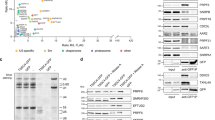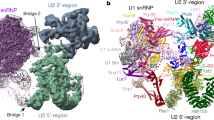Abstract
The spliceosome uses numerous strategies to regulate its function in mRNA maturation. Ubiquitin regulates many cellular processes, but its potential roles during splicing are unknown. We have developed a new strategy that reveals a direct role for ubiquitin in the dynamics of splicing complexes. A ubiquitin mutant (I44A) that can enter the conjugation pathway but is compromised in downstream functions diminishes splicing activity by reducing the levels of the U4/U6-U5 small nuclear ribonucleoprotein (snRNP). Similarly, an inhibitor of ubiquitin's protein-protein interactions, ubistatin A, reduces U4/U6-U5 triple snRNP levels in vitro. When ubiquitin interactions are blocked, ATP-dependent disassembly of purified U4/U6-U5 particles is accelerated, indicating a direct role for ubiquitin in repressing U4/U6 unwinding. Finally, we show that the conserved splicing factor Prp8 is ubiquitinated within purified triple snRNPs. These results reveal a previously unknown ubiquitin-dependent mechanism for controlling the pre-mRNA splicing pathway.
This is a preview of subscription content, access via your institution
Access options
Subscribe to this journal
Receive 12 print issues and online access
$189.00 per year
only $15.75 per issue
Buy this article
- Purchase on Springer Link
- Instant access to full article PDF
Prices may be subject to local taxes which are calculated during checkout







Similar content being viewed by others
References
Will, C.L. & Lührmann, R. Spliceosome structure and function. in The RNA World (eds. Gesteland, R.F., Cech, T.R. & Atkins, J.F.) 369–400 (Cold Spring Harbor Laboratory Press, Cold Spring Harbor, NY, 2006).
Staley, J.P. & Guthrie, C. Mechanical devices of the spliceosome: motors, clocks, springs, and things. Cell 92, 315–326 (1998).
Kuhn, A.N., Li, Z. & Brow, D.A. Splicing factor Prp8 governs U4/U6 RNA unwinding during activation of the spliceosome. Mol. Cell 3, 65–75 (1999).
Small, E.C., Leggett, S.R., Winans, A.A. & Staley, J.P. The EF-G-like GTPase Snu114p regulates spliceosome dynamics mediated by Brr2p, a DExD/H box ATPase. Mol. Cell 23, 389–399 (2006).
Misteli, T. RNA splicing: what has phosphorylation got to do with it? Curr. Biol. 9, R198–R200 (1999).
Pickart, C.M. & Eddins, M.J. Ubiquitin: structures, functions, mechanisms. Biochim. Biophys. Acta 1695, 55–72 (2004).
Welchman, R.L., Gordon, C. & Mayer, R.J. Ubiquitin and ubiquitin-like proteins as multifunctional signals. Nat. Rev. Mol. Cell Biol. 6, 599–609 (2005).
Hershko, A. & Ciechanover, A. The ubiquitin system. Annu. Rev. Biochem. 67, 425–479 (1998).
Amerik, A.Y. & Hochstrasser, M. Mechanism and function of deubiquitinating enzymes. Biochim. Biophys. Acta 1695, 189–207 (2004).
Hicke, L., Schubert, H.L. & Hill, C.P. Ubiquitin-binding domains. Nat. Rev. Mol. Cell Biol. 6, 610–621 (2005).
Rappsilber, J., Ryder, U., Lamond, A.I. & Mann, M. Large-scale proteomic analysis of the human spliceosome. Genome Res. 12, 1231–1245 (2002).
Makarov, E.M. et al. Small nuclear ribonucleoprotein remodeling during catalytic activation of the spliceosome. Science 298, 2205–2208 (2002).
Peng, J. et al. A proteomics approach to understanding protein ubiquitination. Nat. Biotechnol. 21, 921–926 (2003).
Hatakeyama, S., Yada, M., Matsumoto, M., Ishida, N. & Nakayama, K.I. U box proteins as a new family of ubiquitin-protein ligases. J. Biol. Chem. 276, 33111–33120 (2001).
Ohi, M.D., Vander Kooi, C.W., Rosenberg, J.A., Chazin, W.J. & Gould, K.L. Structural insights into the U-box, a domain associated with multi-ubiquitination. Nat. Struct. Biol. 10, 250–255 (2003).
Bellare, P., Kutach, A.K., Rines, A.K., Guthrie, C. & Sontheimer, E.J. Ubiquitin binding by a variant Jab1/MPN domain in the essential pre-mRNA splicing factor Prp8p. RNA 12, 292–302 (2006).
Kramer, A., Mulhauser, F., Wersig, C., Groning, K. & Bilbe, G. Mammalian splicing factor SF3a120 represents a new member of the SURP family of proteins and is homologous to the essential splicing factor PRP21p of Saccharomyces cerevisiae. RNA 1, 260–272 (1995).
Lygerou, Z., Christophides, G. & Seraphin, B. A novel genetic screen for snRNP assembly factors in yeast identifies a conserved protein, Sad1p, also required for pre-mRNA splicing. Mol. Cell. Biol. 19, 2008–2020 (1999).
Makarova, O.V., Makarov, E.M. & Luhrmann, R. The 65 and 110 kDa SR-related proteins of the U4/U6.U5 tri-snRNP are essential for the assembly of mature spliceosomes. EMBO J. 20, 2553–2563 (2001).
Pena, V., Liu, S., Bujnicki, J.M., Luhrmann, R. & Wahl, M.C. Structure of a multipartite protein-protein interaction domain in splicing factor prp8 and its link to retinitis pigmentosa. Mol. Cell 25, 615–624 (2007).
Zhang, L. et al. Crystal structure of the C-terminal domain of splicing factor Prp8 carrying retinitis pigmentosa mutants. Protein Sci. 16, 1024–1031 (2007).
Wilkinson, C.R. et al. Ubiquitin-like protein Hub1 is required for pre-mRNA splicing and localization of an essential splicing factor in fission yeast. Curr. Biol. 14, 2283–2288 (2004).
Raghunathan, P.L. & Guthrie, C. RNA unwinding in U4/U6 snRNPs requires ATP hydrolysis and the DEIH-box splicing factor Brr2. Curr. Biol. 8, 847–855 (1998).
Stevens, S.W. et al. Composition and functional characterization of the yeast spliceosomal penta-snRNP. Mol. Cell 9, 31–44 (2002).
Beal, R., Deveraux, Q., Xia, G., Rechsteiner, M. & Pickart, C. Surface hydrophobic residues of multiubiquitin chains essential for proteolytic targeting. Proc. Natl. Acad. Sci. USA 93, 861–866 (1996).
Sloper-Mould, K.E., Jemc, J.C., Pickart, C.M. & Hicke, L. Distinct functional surface regions on ubiquitin. J. Biol. Chem. 276, 30483–30489 (2001).
Spence, J. et al. Cell cycle-regulated modification of the ribosome by a variant multiubiquitin chain. Cell 102, 67–76 (2000).
Ghaemmaghami, S. et al. Global analysis of protein expression in yeast. Nature 425, 737–741 (2003).
Ecker, D.J. et al. Gene synthesis, expression, structures, and functional activities of site-specific mutants of ubiquitin. J. Biol. Chem. 262, 14213–14221 (1987).
Wilkinson, K.D. & Audhya, T.K. Stimulation of ATP-dependent proteolysis requires ubiquitin with the COOH-terminal sequence Arg-Gly-Gly. J. Biol. Chem. 256, 9235–9241 (1981).
Lee, D.H. & Goldberg, A.L. Proteasome inhibitors: valuable new tools for cell biologists. Trends Cell Biol. 8, 397–403 (1998).
Grainger, R.J. & Beggs, J.D. Prp8 protein: at the heart of the spliceosome. RNA 11, 533–557 (2005).
Verma, R. et al. Ubistatins inhibit proteasome-dependent degradation by binding the ubiquitin chain. Science 306, 117–120 (2004).
Stevens, S.W. et al. Biochemical and genetic analyses of the U5, U6, and U4/U6U5 small nuclear ribonucleoproteins from Saccharomyces cerevisiae. RNA 7, 1543–1553 (2001).
Kim, D.H. & Rossi, J.J. The first ATPase domain of the yeast 246-kDa protein is required for in vivo unwinding of the U4/U6 duplex. RNA 5, 959–971 (1999).
Laggerbauer, B., Achsel, T. & Luhrmann, R. The human U5–200kD DEXH-box protein unwinds U4/U6 RNA duplices in vitro. Proc. Natl. Acad. Sci. USA 95, 4188–4192 (1998).
van Nues, R.W. & Beggs, J.D. Functional contacts with a range of splicing proteins suggest a central role for Brr2p in the dynamic control of the order of events in spliceosomes of Saccharomyces cerevisiae. Genetics 157, 1451–1467 (2001).
Hershko, A. & Rose, I.A. Ubiquitin-aldehyde: a general inhibitor of ubiquitin-recycling processes. Proc. Natl. Acad. Sci. USA 84, 1829–1833 (1987).
Schnell, J.D. & Hicke, L. Non-traditional functions of ubiquitin and ubiquitin-binding proteins. J. Biol. Chem. 278, 35857–35860 (2003).
Boon, K.-L., Norman, C.M., Grainger, R.J., Newman, A.J. & Beggs, J.D. Prp8p dissection reveals domain structure and protein interaction sites. RNA 12, 198–205 (2006).
Liu, S., Rauhut, R., Vornlocher, H.P. & Luhrmann, R. The network of protein-protein interactions within the human U4/U6.U5 tri-snRNP. RNA 12, 1418–1430 (2006).
Chan, S.P., Kao, D.I., Tsai, W.Y. & Cheng, S.C. The Prp19p-associated complex in spliceosome activation. Science 302, 279–282 (2003).
Brenner, T.J. & Guthrie, C. Genetic analysis reveals a role for the C-terminus of the Saccharomyces cerevisiae GTPase Snu114 during spliceosome activation. Genetics 170, 1063–1080 (2005).
Bartels, C., Klatt, C., Luhrmann, R. & Fabrizio, P. The ribosomal translocase homologue Snu114p is involved in unwinding U4/U6 RNA during activation of the spliceosome. EMBO Rep. 3, 875–880 (2002).
Bartels, C., Urlaub, H., Luhrmann, R. & Fabrizio, P. Mutagenesis suggests several roles of Snu114p in pre-mRNA splicing. J. Biol. Chem. 278, 28324–28334 (2003).
Lin, R.J., Newman, A.J., Cheng, S.C. & Abelson, J. Yeast mRNA splicing in vitro. J. Biol. Chem. 260, 14780–14792 (1985).
Cheng, S.C. & Abelson, J. Spliceosome assembly in yeast. Genes Dev. 1, 1014–1027 (1987).
Acknowledgements
We thank L. Hicke and D. Finley for strains and plasmids, J. Beggs for anti-Prp8 antibodies and the Drug Synthesis & Chemistry Branch of the National Cancer Institute for ubistatin A. We are grateful to L. Hicke, S. Prakash and members of the Sontheimer and Staley laboratories for advice and discussions, to S. Stevens (University of Texas, Austin) for communicating unpublished results and to M. French, D. Golden, J. Pellino, S. Prakash and J. Preall for critical reading of this manuscript. This work was supported by a US National Institutes of Health grant (GM62264) to J.P.S. and a US National Science Foundation CAREER Award (MCB-0093003) and a US National Institutes of Health grant (GM072830) to E.J.S.
Author information
Authors and Affiliations
Contributions
P.B., E.C.S., X.H., J.A.W., J.P.S. and E.J.S. designed the experiments; P.B., E.C.S., X.H. and J.A.W. performed the experiments; P.B., E.C.S., X.H., J.A.W., J.P.S. and E.J.S. analyzed the data; and P.B., E.C.S., J.A.W., J.P.S. and E.J.S. wrote the paper.
Corresponding author
Supplementary information
Supplementary Text and Figures
Supplementary Figures 1–7, Supplementary Table 1, Supplementary Results and Supplementary Methods (PDF 9352 kb)
Rights and permissions
About this article
Cite this article
Bellare, P., Small, E., Huang, X. et al. A role for ubiquitin in the spliceosome assembly pathway. Nat Struct Mol Biol 15, 444–451 (2008). https://doi.org/10.1038/nsmb.1401
Received:
Accepted:
Published:
Issue Date:
DOI: https://doi.org/10.1038/nsmb.1401
This article is cited by
-
Deubiquitinase USP47-stabilized splicing factor IK regulates the splicing of ATM pre-mRNA
Cell Death Discovery (2020)
-
Intron specificity in pre-mRNA splicing
Current Genetics (2018)
-
Post translational modification of Parkin
Biology Direct (2017)
-
Frequent mutations in acetylation and ubiquitination sites suggest novel driver mechanisms of cancer
Genome Medicine (2016)
-
Diverse regulation of 3′ splice site usage
Cellular and Molecular Life Sciences (2015)



